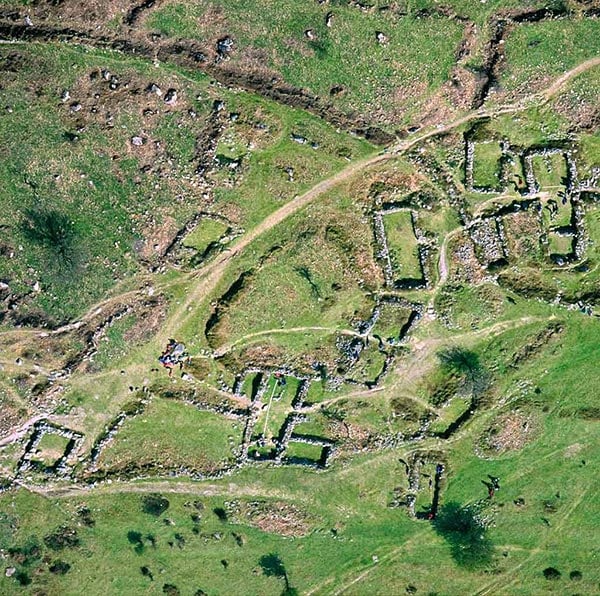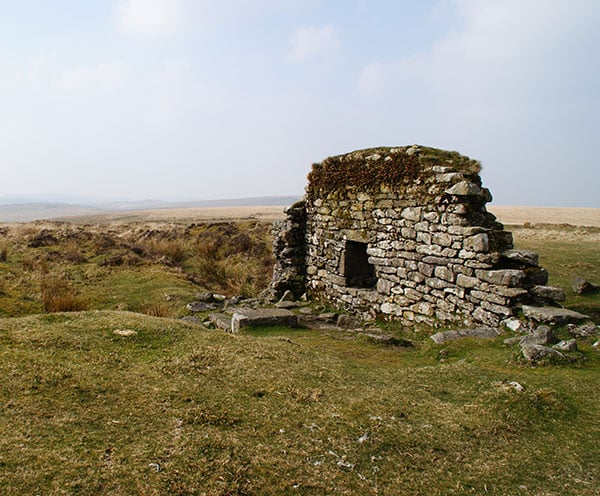A Brief History of Dartmoor
Dartmoor in prehistory

Dartmoor’s granite rocks were forged about 280 million years ago, and gradually eroded to form the characteristic rocky outcrops known as tors. In the Mesolithic period (c.10,000 to 4000 BC) Dartmoor was a largely wooded landscape, in which small groups of people hunted wild animals such as deer and wild auroch cattle, and gathered berries and nuts. As agriculture gradually developed in the Neolithic period (c.4000 to 2300 BC), the early farmers began to clear the woodland in the lower parts of Dartmoor to create pasture for their animals. They also built communal tombs, such as the burial chamber at Spinsters’ Rock near Drewsteignton.
The population seems to have increased from about 2500 BC. Late Neolithic and Bronze Age farming communities continued to clear the woodland and built more elaborate monuments. At Merrivale, for example, the remains include three stone rows and a stone circle, which are part of a monumental landscape built by the living to commemorate the dead.
Bronze Age (c.2300 to 800 BC) farmers also built small villages of roundhouses, including Grimspound, one of the largest Bronze Age villages on Dartmoor. On the lower moors, these farming communities started to mark out the landscape with long stone and earth boundary walls, known as reaves, and smaller field walls.
But by clearing so much woodland for pasture, the Bronze Age farmers over-exploited the upland environment. The soils on the granite upland, cleared of woodland, were fragile, so from about 1000 BC they were becoming waterlogged. Peat bog began to blanket the depleted soils, which could no longer sustain a large year-round farming population. The settlements and fields were abandoned and Dartmoor became a summer grazing area.
Medieval hamlets

Between about AD 950 and 1250, year-round farming gradually returned to Dartmoor. The population of England was increasing and the climate was improving. Average temperatures and rainful were similar to what they had been in the Bronze Age (and to what they would be in the 20th century).
There were tin-trading and agricultural towns on the edge of Dartmoor, including Tavistock, Lydford, Okehampton and Ashburton. Up in the river valleys there were dozens of smaller villages, particularly on the more sheltered east side of Dartmoor. Farming hamlets such as Hound Tor developed higher on the moor around the 13th century, and for a century or two the residents managed to grow oats and rye there. New sheep farms were established on high Duchy of Cornwall land, a few of which survive and are known as ‘ancient tenements’.
By about 1300, however, temperatures were falling and so the summer growing season was getting shorter. Harvest failures and outbreaks of animal disease in the 1310s led to a nationwide famine. A generation later, in 1348–9, the global pandemic known as the Black Death killed around half the population of England. Many of the higher farms and hamlets on Dartmoor were abandoned, although others – particularly the sheep farms – survived.
Dartmoor’s industries

© Herby talk thyme, CC BY-SA 4.0
During the medieval period tin ore was mined on Dartmoor and then processed and sold to make pewter plates and drinking vessels. The tin mining industry subsequently declined, but revived in the 18th and 19th centuries. The Industrial Revolution stimulated demand for tin and improved the technologies that made underground tin mining viable. Earthwork remains of the extensive water-powered mining and processing industry known as tin streaming can be seen in the Plym Valley. Nearby, the remains of the Eylesbarrow mine, which operated in the 1830s and 1840s, can be seen.
Several stone quarries opened on Dartmoor in the 19th century, including Haytor quarry, which supplied granite for London buildings including the British Museum. Entrepreneurs tried other industries on the moor, including the gunpowder factory at Powdermills near Postbridge in the second half of the 19th century.
Dartmoor today

Parts of the moor are used for military training and there is still some industrial activity including china clay extraction and stone quarrying.
In 1951 Dartmoor became one of the first national parks, with the land managed by a public body now called the Dartmoor National Park Authority. They have to balance the interests of farming and tourism, as well as the natural and historic environment. English Heritage works with the Park Authority to look after the sites at Merrivale, Grimspound, the Upper Plym Valley and Hound Tor.















